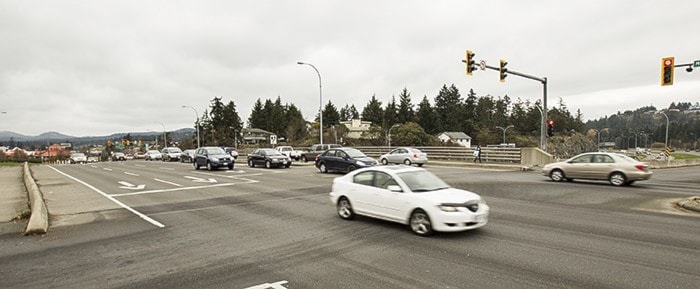Re: Langford road works aim to streamline traffic flow (Gazette, Nov. 18)
A full-page article on traffic flow improvements in Langford. But only for motor cars; nothing for people, pedestrians, cyclists, youth, seniors, handicapped riding scooters, etc.
North Langford is separated from the city’s downtown by the Trans-Canada Highway, with absolutely no practical pedestrian crossing, only an extensive fence in its median. In spite of repeated public promises in the past, moneys that had been provisionally set aside for a pedestrian crossing were spent on other things, and all those firm and assured promises were reneged upon.
Transit across the TCH has actually been reduced over the past few years to only two routes: the No. 52 and the 56/57.
The No. 52 only serves the car-oriented Millstream commercial district, not residential areas. The 56/57 is a merged, hourly route that strings all over North Langford to or from the Phelps subdivision at one end, and to or from Westhills at the other. The Phelps neighbourhood would be better served by the 52.
This poor, reduced transit service for North Langford has, of course, resulted in poor, reduced ridership in turn. Dogpatch Langford still exists; it has only moved to North-Langford residential areas, behind the extensive fencing on the highway.
While the headline read “Langford road works aim to streamline traffic flow,” that is only true for the very short term. Over the long term, the city’s road works aim to “streamline” traffic gridlock by attracting more cars. That is, if other modes of traffic, such as pedestrians, bicycles and transit, are ignored and not dealt with pretty soon, starting with a pedestrian overpass.
Axel Brock-Miller
Langford
McKenzie interchange a short-term solution
Re: McKenzie interchange
Will the rebuilding of the McKenzie Avenue/Trans Canada Highway intersection improve the severe rush hour congestion for those from the West Shore wishing to access the city centre and the Pat Bay highway? Will the “20 minutes to town” mantra ever be a reality in rush hour? Not likely. The growth of traffic from the West Shore is sure to continue to outstrip the capabilities of the Trans Canada corridor, McKenzie fix or not. The fix is short-term. Other cities are looking longer term.
Calgary, for example, has severe rush hour congestion and recently won federal funding to extend light rail service. Fortunately for Calgary, traffic planning does not involve 13 separate jurisdictions.
The recent Ecofiscal Commission report on traffic congestion in Canada suggests that cities consider “congestion charging,” such as high occupancy toll lanes. I-405 in Seattle has already introduced this type of toll. Meanwhile, citizens here are asked to consider only the details of a short-term fix.
What are the prospects for reducing congestion in the long run? At the moment they are not good unless light rail, diamond lanes (HOV) and congestion charging are considered in comprehensive transportation planning for a region of some 350,000 people.
As a recent California depart-ment of transportation report concluded, building more free access to roads simply generates more traffic. You can’t beat congestion that way, it says. They should know! Who will make plans in this fragmented region that face up to this fact?
John Olson
Colwood
